Overview
- Brief Narrative
- Scrip, valued at 1 krone, issued in the Theresienstadt (Terezin) ghetto-labor camp in 1943. All currency was confiscated from deportees upon entry and replaced with scrip and ration coupons that could be exchanged only in the camp. The Theresienstadt camp existed for 3.5 years, from November 24, 1941 to May 9, 1945. It was located in a region of Czechoslovakia occupied by Germany, renamed the Protectorate of Bohemia and Moravia, and made part of the Greater German Reich.
- Date
-
issue:
1943 January 01
- Geography
-
issue:
Theresienstadt (Concentration camp);
Terezin (Ustecky kraj, Czech Republic)
- Credit Line
- United States Holocaust Memorial Museum Collection, Gift of Charlotte Schiff
- Markings
- front, upper center, printed in green ink : QUITTUNG ÜBER / EINE KRONE [RECEIPT OF / ONE CROWN]
front, lower center, printed in middle text then above in green ink : 1
front, lower center, smaller text than above, printed in green ink : WER DIESE QUITTUNG VERFÄLSCHT ODER NACHMACHT / ODER GEFÄLSCHTE QUITTUNGEN IN VERKEHR BRINGT. / WIRD STRENGSTENS BESTRAFT [ANYONE WHO FALSIFIES OR DISTORTS OR FAKES THIS RECEIPT, OR COUNTERFEITS RECEIPT, WILL BE STRICTLY PUNISHED]
reverse, upper left in border, plate letter and number, printed in green ink : A044
reverse, center, printed in green ink : Quittung / über / EINE KRONE [Receipt / of / ONE CROWN]
reverse, lower center, printed in green ink : THERESIENSTADT, AM 1.JANNER 1943 DER ALTESTE DER JUDEN / IN THERESIENSTADT [THERESIENSTADT, ON 1. JANUARY 1943 THE ELDER OF THE JEWS IN THERESIENSTADT]
reverse, bottom right, printed in green ink : Jakob Edelstein
Physical Details
- Language
- German
- Classification
-
Exchange Media
- Category
-
Money
- Object Type
-
Scrip (aat)
- Physical Description
- Rectangular paper scrip. The front has a graphic design in black and green ink on a green background. The front depicts Moses holding 2 stone tablets with the 10 Commandments in Hebrew characters within a medallion on the left, with German text on the right. The right side has a wide, off-white border with the denomination 1 in the lower corner and a 6-pointed Star of David above. The reverse has a green geometric background design with German text and a scrollwork line. Below the text is an engraved signature. The denomination 1 is in the upper right corner. The left side has a wide, off-white border with the denomination 1 in the lower corner with a 6-pointed Star of David above. The plate letter and number is in the upper left corner.
- Dimensions
- overall: Height: 2.000 inches (5.08 cm) | Width: 4.000 inches (10.16 cm)
- Materials
- overall : paper, ink
Rights & Restrictions
- Conditions on Access
- No restrictions on access
- Conditions on Use
- No restrictions on use
Keywords & Subjects
Administrative Notes
- Legal Status
- Permanent Collection
- Provenance
- The Theresienstadt scrip was donated to the United States Holocaust Memorial Museum in 2000 by Charlotte Schiff.
- Record last modified:
- 2022-07-28 18:28:39
- This page:
- https://collections.ushmm.org/search/catalog/irn515126
Download & Licensing
In-Person Research
- By Appointment
- Request 21 Days in Advance of Visit
- Plan a Research Visit
- Request to See This Object
Contact Us
Also in Charlotte Schiff collection
Collection of armbands, Star of David badge, documents, scrip, and a drawing relating to Charlotte Schiff's (Charlotte Goldschmidt) experiences during the Holocaust in Terezin (Theresienstadt) and her registration as a displaced person.
Date: 1943-1946

Armband from Terezin ghetto-labor camp
Object
Armband, white fabric with two rows of dark stitching, "K.L." written in blue ink inside triangle, "Terezin" written beneath triangle, two circular ink stamps (one of either side of triangle, reading "Zamosprava Byv. Gheta Terezina" with image of snake wrapped around pole in center).
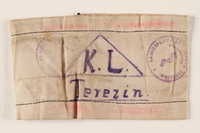
Armband from Terezin ghetto-labor camp
Object
Armband, white fabric with two rows of dark stitching, "K.L." written in blue ink inside triangle, "Terezin" written beneath triangle, two circular ink stamps (one of either side of triangle, reading "Zamosprava Byv. Gheta Terezina" with image of snake wrapped around pole in center).

Theresienstadt ghetto-labor camp scrip, 1 krone note
Object
Scrip, valued at 1 krone, issued in the Theresienstadt (Terezin) ghetto-labor camp in 1943. All currency was confiscated from deportees upon entry and replaced with scrip and ration coupons that could be exchanged only in the camp. The Theresienstadt camp existed for 3.5 years, from November 24, 1941 to May 9, 1945. It was located in a region of Czechoslovakia occupied by Germany, renamed the Protectorate of Bohemia and Moravia, and made part of the Greater German Reich.

Theresienstadt ghetto-labor camp scrip, 1 krone note
Object
Scrip, valued at 1 krone, issued in the Theresienstadt (Terezin) ghetto-labor camp in 1943. All currency was confiscated from deportees upon entry and replaced with scrip and ration coupons that could be exchanged only in the camp. The Theresienstadt camp existed for 3.5 years, from November 24, 1941 to May 9, 1945. It was located in a region of Czechoslovakia occupied by Germany, renamed the Protectorate of Bohemia and Moravia, and made part of the Greater German Reich.

Theresienstadt ghetto-labor camp scrip, 2 kronen note
Object
Scrip, valued at 2 kronen, issued in the Theresienstadt (Terezin) ghetto-labor camp in 1943. All currency was confiscated from deportees upon entry and replaced with scrip and ration coupons that could be exchanged only in the camp. The Theresienstadt camp existed for 3.5 years, from November 24, 1941 to May 9, 1945. It was located in a region of Czechoslovakia occupied by Germany, renamed the Protectorate of Bohemia and Moravia, and made part of the Greater German Reich.
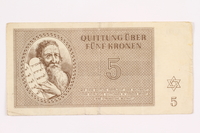
Theresienstadt ghetto-labor camp scrip, 5 kronen note
Object
Scrip, valued at 5 kronen, issued in the Theresienstadt (Terezin) ghetto-labor camp in 1943. All currency was confiscated from deportees upon entry and replaced with scrip and ration coupons that could be exchanged only in the camp. The Theresienstadt camp existed for 3.5 years, from November 24, 1941 to May 9, 1945. It was located in a region of Czechoslovakia occupied by Germany, renamed the Protectorate of Bohemia and Moravia, and made part of the Greater German Reich.
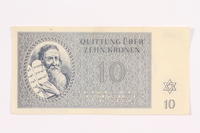
Theresienstadt ghetto-labor camp scrip, 10 kronen note
Object
Scrip, valued at 10 kronen, issued in the Theresienstadt (Terezin) ghetto-labor camp in 1943. All currency was confiscated from deportees upon entry and replaced with scrip and ration coupons that could be exchanged only in the camp. The Theresienstadt camp existed for 3.5 years, from November 24, 1941 to May 9, 1945. It was located in a region of Czechoslovakia occupied by Germany, renamed the Protectorate of Bohemia and Moravia, and made part of the Greater German Reich.
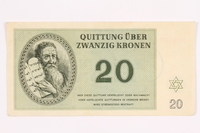
Theresienstadt ghetto-labor camp scrip, 20 kronen note
Object
Scrip, valued at 20 kronen, issued in the Theresienstadt (Terezin) ghetto-labor camp in 1943. All currency was confiscated from deportees upon entry and replaced with scrip and ration coupons that could be exchanged only in the camp. The Theresienstadt camp existed for 3.5 years, from November 24, 1941 to May 9, 1945. It was located in a region of Czechoslovakia occupied by Germany, renamed the Protectorate of Bohemia and Moravia, and made part of the Greater German Reich.

Theresienstadt ghetto-labor camp scrip, 50 kronen note
Object
Scrip, valued at 50 kronen, issued in the Theresienstadt (Terezin) ghetto-labor camp in 1943. All currency was confiscated from deportees upon entry and replaced with scrip and ration coupons that could be exchanged only in the camp. The Theresienstadt camp existed for 3.5 years, from November 24, 1941 to May 9, 1945. It was located in a region of Czechoslovakia occupied by Germany, renamed the Protectorate of Bohemia and Moravia, and made part of the Greater German Reich.
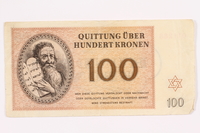
Theresienstadt ghetto-labor camp scrip, 100 kronen note
Object
Scrip, valued at 100 kronen, issued in the Theresienstadt (Terezin) ghetto-labor camp in 1943. All currency was confiscated from deportees upon entry and replaced with scrip and ration coupons that could be exchanged only in the camp. The Theresienstadt camp existed for 3.5 years, from November 24, 1941 to May 9, 1945. It was located in a region of Czechoslovakia occupied by Germany, renamed the Protectorate of Bohemia and Moravia, and made part of the Greater German Reich.
Charlotte Schiff papers
Document
Documents relating to Charlotte Schiff's (Charlotte Goldschmidt) [donor] experiences during the Holocaust. The documents include identification card, "Sonderausweis," issued to Charlotte Goldschmidt (donor) who had been imprisoned in Theresiendtadt concentration camp; issued July 26, 1946; Frankfurt, Germany. Indentifiaction card, "United Nations Displaced Person/Refugee Identification card," issued to Charlotte Goldschmidt. Identification card, Sonderausweis, for Irma Goldschmidt, donor's mother issued July 26, 1946. Registration card from the Czechoslovak Repatriation Office for Charlotte, isssued July 1, 1945.
Print of a Bedrich Fritta street scene
Object
Postwar print of a street scene drawn by Bedrich Fritta while a prisoner in Theresienstadt ghetto-labor camp. Fritta, a Czech Jewish cartoonist and graphic designer, was deported to the camp from Prague on November 24, 1941. He was assigned to head the Graphic Department. Fritta was part of a tight knit group of artists determined to secretly document the wretched conditions of daily life in the camp. In summer 1944, they were accused by the Gestapo of smuggling their 'gruesome', atrocity propaganda, that is realistic, work out of the camp. Fritta, his wife Hansi, and son Tomas, 3, were sent to prison. Fritta was tortured. His wife died of starvation or typhus. On October 26, Fritta, with artist Leo Haas, was deported to Auschwitz, where he died, age 37, on November 9, 1944. His son Tomas survived and was adopted by Leo Haas. Nearly 200 of Fritta's drawings were hidden and preserved by other inmates.




